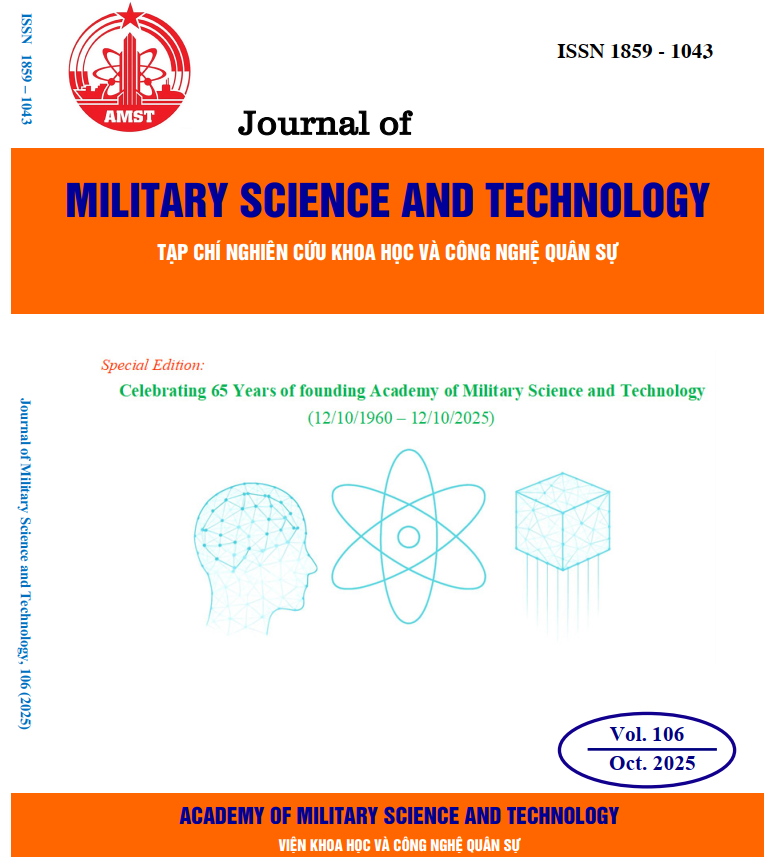Analyzing some main components of MDF-500 disinfectant produced in the United States
192 viewsDOI:
https://doi.org/10.54939/1859-1043.j.mst.106.2025.63-71Keywords:
MDF-500; Disinfectant; Hydrogen peroxide.Abstract
The demand for disinfectants has increased exponentially globally following the COVID-19 pandemic to prevent and control the risk of exposure to harmful microorganisms in humans, the environment, and infrastructure. Contaminated surfaces are places where microorganisms can survive for many days. MDF-500 disinfectant has been recommended by the Environmental Protection Agency (EPA) of the USA. MDF-500 disinfectant has a broad spectrum of antibacterial activity against chemical and biological agents. Although widely used, information on the composition of MDF-500 is minimal. Therefore, it is necessary to conduct analytical research to determine the main components of MDF-500 using qualitative and quantitative techniques, as a basis for improving and upgrading technical features. The main components identified include hydrogen peroxide (H2O2), sodium hypochlorite (NaOCl), benzalkonium chloride, cetyltrimethylammonium bromide, and cetylpyridinium chloride. The analysis showed that MDF-500 disinfectant consisted of 1.25% H2O2, 9.47% NaOCl, and pH = 10.74.
References
[1]. Epelle, E. I., Macfarlane, A., Cusack, M., Burns, A., Okolie, J. A., Vichare, P., Rolland, L., & Yaseen, M. "Ozone decontamination of medical and nonmedical devices: an assessment of design and implementation considerations." Industrial & Engineering Chemistry Research, 62, 4191–4209, (2023). DOI: https://doi.org/10.1021/acs.iecr.2c03754
[2]. Dhama, K., Patel, S. K., Kumar, R., Masand, R., Rana, J., Yatoo, M. I., Tiwari, R., Sharun, K., Mohapatra, R. K., & Natesan, S. "The role of disinfectants and sanitizers during COVID-19 pandemic: advantages and deleterious effects on humans and the environment." Environmental Science and Pollution Research, 28, 34211–34228, (2021). DOI: https://doi.org/10.1007/s11356-021-14429-w
[3]. Sahu, R., Sahoo, R. K., Prusty, S. K., & Sahu, P. K. "Urinary tract infection and its management." Systematic Reviews in Pharmacy, 10, 42–48, (2019). DOI: https://doi.org/10.5530/srp.2019.1.7
[4]. Fink, K., Örgel, M., Baier, C., Brauckmann, V., Giannoudis, V., & Liodakis, E. "Quality of lower limb preoperative skin preparation using colorless versus colored disinfectants – results of an experimental, randomized study in a close to reality setting." PLoS One, 18, e0282662, (2023). DOI: https://doi.org/10.1371/journal.pone.0282662
[5]. Tadros, M. E., & Tucker, M. D. Formulations for neutralization of chemical and biological toxants. Sandia National Laboratories, Livermore, CA, USA, (2003).
[6]. Tucker, M. D., & Engler, D. E. Decontamination formulations for disinfection and sterilization. Google Patents, (2007).
[7]. USP-NF. "United States Pharmacopeia." United States Pharmacopeia, (2024).
[8]. "Xác định nhiệt độ sôi và khoảng chưng cất." Vietnamese Pharmacopoeia (in Vietnamese).
[9]. "TCVN 3731:2007 (ISO 758:1976) về sản phẩm hóa học dạng lỏng sử dụng trong công nghiệp – xác định khối lượng riêng ở 20 °C." (in Vietnamese).
[10]. "TCVN 6185:2015 (ISO 7887:2011) về Chất lượng nước – Kiểm tra và xác định độ màu." (in Vietnamese).
[11]. Auerbach, M. E., & Browning, R. S. “Test composition for determining the concentration of quaternary ammonium compounds in aqueous solution”. Google Patents, (1961).
[12]. Lin, H., Zhu, H., Guo, J., & Wang, N. "Interactions between bromophenol blue and cetyl-trimethylammonium bromide in aqueous solutions and microemulsions." Journal of Dispersion Science and Technology, 38, 1410–1414, (2017). DOI: https://doi.org/10.1080/01932691.2016.1250215
[13]. Sobika, M., Karunanithi, S., & Dash, S. "Studies on anionic dye Eosin Y in mixed anionic micellar medium." Results in Chemistry, 7, 101220, (2024). DOI: https://doi.org/10.1016/j.rechem.2023.101220
[14]. Yoo, M. J., & Park, H. B. "Effect of hydrogen peroxide on properties of graphene oxide in Hummers method." Carbon, 141, 515–522, (2019). DOI: https://doi.org/10.1016/j.carbon.2018.10.009
[15]. Trautmann, E., Attin, T., Mohn, D., & Zehnder, M. "Hydrogen peroxide versus sodium hypochlorite: all a matter of pH?" Journal of Endodontics, 47, 297–302, (2021). DOI: https://doi.org/10.1016/j.joen.2020.10.016
[16]. Artasensi, A., Mazzotta, S., & Fumagalli, L. "Back to basics: choosing the appropriate surface disinfectant." Antibiotics, 10, 613, (2021). DOI: https://doi.org/10.3390/antibiotics10060613
[17]. McFadden, J., Holloway, D., Whittle, E., & Basketter, D. "Benzalkonium chloride neutralizes the irritant effect of sodium dodecyl sulfate." Contact Dermatitis, 43, 264–266, (2000). DOI: https://doi.org/10.1034/j.1600-0536.2000.043005264.x
[18]. Burel, C., Direur, G., Rivas, C., & Purevdorj‐Gage, L. "Colorimetric detection of residual quaternary ammonium compounds on dry surfaces and prediction of antimicrobial activity using bromophenol blue." Letters in Applied Microbiology, 72, 358–365, (2021). DOI: https://doi.org/10.1111/lam.13429
[19]. Zheng, J., Ma, Z., Zhang, Q., Qiu, L., Wang, Z., & Wang, N. "Effect of CTAB premicelle and micelle formation on Bromophenol Blue spectra." ChemistrySelect, 9, e202400090, (2024). DOI: https://doi.org/10.1002/slct.202400090
[20]. Colichman, E. L. "Spectral study of long chain quaternary ammonium salts in brom phenol blue solutions." Journal of the American Chemical Society, 73, 3385–3388, (1951). DOI: https://doi.org/10.1021/ja01151a113
[21]. Erdinc, N., & Göktürk, S. "Spectrophotometric and conductometric studies on the interaction of anionic dye eosin-y with cationic micelles." Analytical Chemistry Letters, 4, 146–157, (2014). DOI: https://doi.org/10.1080/22297928.2014.960534
[22]. Yadav, C. K., Adhikari, M. K., Maharjan, J., & Bhattarai, A. "An analysis of cetylpyridinium chloride (CPC) by FESEM, EDX methods, and its applications." Rajarshi Janak University Research Journal, 2, 1–7, (2024). DOI: https://doi.org/10.3126/rjurj.v2i1-2.72263
[23]. Yadav, C. K., Niraula, T. P., Neupane, S., Yadav, A. P., & Bhattarai, A. "Study of anti-corrosion properties of sodium dodecyl sulphate and cetyl pyridinium chloride." Journal of Nepal Chemical Society, 44, 163–172, (2024). DOI: https://doi.org/10.3126/jncs.v44i1.62690
[24]. "MDF-500 Part A EPA Registered disinfectant." Source: https://thermacote.com/wp-content/uploads/SDS-MDF-500-Part-A-3.20.pdf; "MDF-500 Part B EPA Registered disinfectant." Source: https://thermacote.com/wp-content/uploads/SDS-MDF-500-part-B-3.20.pdf; "MDF-500: Industrial-Grade Disinfectant." Source: https://thermacote.com/mdf500-industrial-disinfectant/, (2020).
[25]. Haque, A. "An exclusive handbook of flexible packaging materials: equipped with raw materials, manufacturing & quality machinery & procedures, case studies and troubleshooting’s." (2024). DOI: https://doi.org/10.2139/ssrn.4873582







